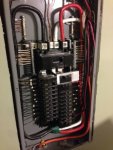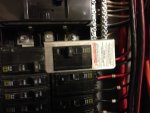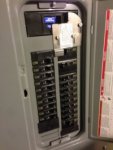
Ok. This thread is important to me as I just won an auction for my 002 and will be picking it up Wednesday.
This post is regarding MY set up only. This post is not to be used for EVERYONES wiring. Please consult your electrician for further questions.
So I have some comments to make and additionally some questions.
We all know that a houses multi neutral ground should only be attached to the home panel box in ONE place in a simple residential application like mine. Above is a picture of my 3 month old Square D QO, 150 amp, 30 space electrical panel that my electrician brother in law installed for me.
Several things to point out.
Orange arrow points to 30 amp romex and breaker which will be moved to the upper right most spot and an interlock kit installed once I get the generator and get it running. I may have to run fresh wire from the inlet box to the new spaces in the panel box as my brother in law didn't leave enough slack in the inlet box wire to make it to the correct spot.
Yellow circles show the three neutral bus bars in the panel. A fourth on the left side stacked on top of the first was not required.
My green highlighted stranded ground wire comes from the cold water pipe before the water meter in the center of the houses floor plan and terminates onto the neutral lug in ONE PLACE.
The orange/bronze circles indicate the 2 ground bus bars for the panel. A third you will see is laying at the bottom of the box unused.
The blue dots, circle, and line show and trace the wiring going to the 100 amp subpanel in the center of the houses floor plan. I had my brother install that for my welder and accessories in the garage at the same time as the panel box this past summer. You will notice the blue dots show the 2 hot legs, 1 neutral leg on the neutral bus bar, and ground wire coming from the top and terminating in the neutral bus bar.
The black circle shows where a black 120 folt leg, red 120 volt leg, neutral leg come from the street, and multi neutral stranded ground comes from the cold water pipe and terminate into the main lugs in the panel.
On the romex coming from the power inlet box which is again highlighted by orange arrow, in addition to the 2 hot legs shown by orange dots, the ground wire runs up the left side of panel and terminates into the left ground bus.
Question 1. Is there a legal means of crimping an additional length of romex to the existing power inlet box romex so I can make it go up to the upper right slots without running all new romex ?
Question 2. I understand that with my set up I have to remove the neutral bond strap on the mep-002a. So does that mean that I am kosher with the ground wire in the L14 plug going to the ground bus as I have it now ? What I mean is, ok the wire i'll be buying is 8/4. The 4th wire being the ground, So, at the plug, on the plug lugs, the 2 hots correspond to the hots on the plug, the neutral to neutral, ground to ground, then I attach the plug into the power inlet box, and does that ground wire in the soow wire which is now connected to the ground bus make it all good ? And where at the generator do I attach the soow ground ? On the ground lug on the frame of the generator ?
Edited to add:
Very important: the ground running out to my subpanel seen as the short blue/green traced wire on the right ground bus bar goes to a ground LUG in the subpanel designated for a ground. These grounds are not run parallel to ensure a ground parallel is not created, creating a difference in impedance.
Anyone who has a subpanel MUST be sure this is done correctly.
Also for those who may ask, I will NOT be using my subpanel for anything in the event of a power failure.





